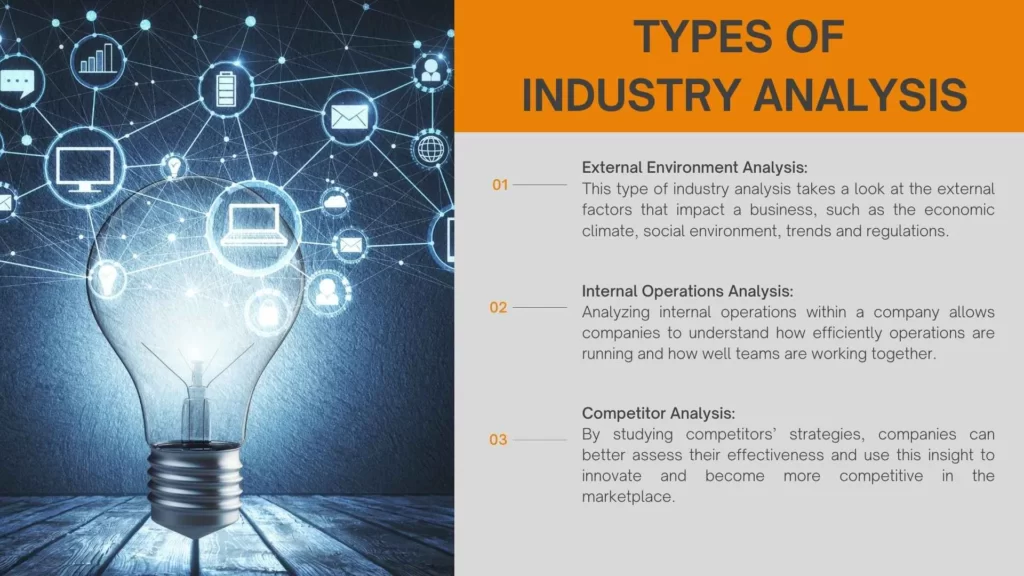Introduction
Industry analysis is an essential tool for understanding the current state and future prospects of a particular sector or market. It involves gathering, analyzing, and interpreting information related to a company or industry in order to get an overall picture of where the industry stands today. It can be used to help inform strategic decisions such as expansion, mergers and acquisitions, pricing, marketing and more.
When conducting industry analysis, there are a variety of different approaches which can be taken depending on the goal of the analysis. These include fundamental analysis which examines financial indicators such as revenue growth rate and debt-equity ratio; technical analysis which looks at price movements over time; and qualitative research which includes interviews with stakeholders in a company or sector.
Additionally, there are various types of industry analyses such as Porter’s Five Forces Framework and SWOT Analysis that provides insights into how competitive forces are influencing a certain industry or sector in an economy.
The benefits of conducting an industry analysis cannot be overstated. By taking a comprehensive look at all aspects relevant to an industry or market—from economic trends, technological advances, demographics and population growth—companies can gain invaluable insights into how best to position themselves in their competitive environment.
Furthermore, conducting regular industry analyses helps identify potential opportunities for companies to capitalize on while staying ahead of the curve amidst ever-changing market conditions.
In conclusion, it is important for any business owner or executive to understand the value of conducting regular industry analyses in order to remain competitive within their respective industries or markets.
Types of Industry Analysis

Industry analysis is an essential tool for companies to help them stay ahead of the competition and understand their markets as they establish their strategies. There are many different types of industry analysis that can be used, each one offering potential benefits to businesses.
External Environment Analysis: This type of industry analysis takes a look at the external factors that impact a business, such as the economic climate, social environment, trends and regulations. Companies can use this information to create strategies that have greater financial security by mitigating risks associated with external environments.
Internal Operations Analysis: Analyzing internal operations within a company allows companies to understand how efficiently operations are running and how well teams are working together. Companies will learn about areas for improvement in order to streamline processes and create greater efficiency.
Competitor Analysis: By studying competitors’ strategies, companies can better assess their effectiveness and use this insight to innovate and become more competitive in the marketplace. For example, they might find ways to differentiate their products or services from those of competitors in order to gain market share.
Market Demand & Supply Analysis: This type of industry analysis focuses on understanding customer needs as well as analyzing supply chains in order to assess supply chain risk management. It also helps businesses identify gaps between demand and supply so they can adjust accordingly within their own operational structures.
Financial & Operational Performance Analysis: Analyzing financial performance reveals how much money the business is producing or losing, while operational performance examines how efficient operations are running. Companies can then take this data into consideration when making decisions that will be beneficial for their bottom line.
Porter’s Five Forces Model is a strategic tool developed by Michael Porter that helps businesses understand the competitive forces within an industry.
It has five components: rivalry among existing competitors, threats of new entrants, bargaining power of buyers, bargaining power of suppliers, and the threat of substitute products or services. By analyzing these components, businesses can gain insight into how they are positioned within their particular industry and identify potential areas for growth and improvement.
SWOT Analysis is another type of analysis used to assess industry competitiveness. This model stands for Strengths, Weaknesses, Opportunities, and Threats and examines both external and internal factors that could influence business performance.
For example, strengths could include having a strong customer base or brand recognition while weaknesses may include outdated technology or limited resources. After evaluating these four components, companies can develop strategies that use their strengths to capitalize on opportunities while minimizing weaknesses and mitigating threats.
It provides businesses with valuable insights that can inform strategic decision-making processes and help them gain an edge over their competitors. By using tools such as Porter’s Five Forces Model and SWOT Analysis to evaluate different aspects of their industry’s competitiveness, businesses can create actionable plans that will allow them to optimize performance while responding to changing markets.
Have a look at the top investment banking course
Benefits of Conducting an Industry Analysis

One of the most important steps to developing a successful business strategy is conducting an industry analysis. It is essential to evaluate the market trends, competitor assessments, and industry opportunities and analyze financial performance to strategize future plans. Conducting an industry analysis helps your business create an effective plan for using resources and understanding customer needs, leading to more success in the long run.
Types of industry analysis can be broken down into two categories: macroenvironmental and microenvironmental analyses. A macroenvironmental analysis looks at economic, social, technological and political factors that could impact your business operations. A microenvironmental analysis assesses internal aspects such as competition, pricing strategies and product development.
There are multiple benefits of conducting an industry analysis that helps inform strategic decision-making in any organization. Market trends are constantly changing so it’s essential to stay updated on what’s happening in your sector in order to seize potential opportunities. Assessing competitors allows you to determine how you can differentiate your product or service while also understanding pricing strategies other players may be implementing. This can give you insight into customer segments or needs that you may not have considered before.
Additionally, resource utilization helps maximize efficiency by creating a plan for allocating resources wisely based on research conducted in the industry analysis process. Finally, analyzing financial performance paints a picture of where your business stands financially and helps inform how future investments should be made.
Overall, conducting an industry analysis is incredibly important for making strategic decisions and planning for future growth within your company or organization. It’s a great way to gain a fuller understanding of both your internal environment as well as external factors impacting operations so you can strategize for success.
Advantages
As a business owner or leader, staying on top of current trends and developments can help you stay competitive in the market. Conducting an industry analysis offers numerous benefits that can be leveraged to grow your business and maximize the efficiency of your resources.
Industry analysis is used to identify potential opportunities for growth, analyze competitors, and anticipate potential risks. It focuses on researching different aspects of the industry to gain insight into the current state of affairs and predict how it might change in the future.
As you know that there are two main types of industry analysis: external and internal. External factors include economic indicators such as GDP and consumer sentiment, while internal factors include pricing strategies, production methods, customer service strategies, etc. By understanding both types of factors at play, businesses are able to recognize areas where they have a competitive advantage over their rivals and areas that need improvement.
The advantages of industry analysis are numerous. For one thing, it provides valuable insights into potential growth opportunities in the marketplace by revealing customer demand for products or services that meet their needs. Additionally, it helps businesses identify target markets that offer the most potential for success by researching demographic trends among those consumers.
Finally, industry analysis allows for better resource allocation by helping businesses understand how much to invest in certain areas versus others based on their needs and goals.
By investing some time into conducting an industry analysis for your business or organization, you can position yourself in a better place both now and in the future. It’s important to remember that no single type of industry analysis will provide all answers needed so it’s important to use a combination of methodologies to get a well-rounded view.
Disadvantages
Industry analysis can be a great tool for companies looking to gain better insights into their competitors and the market. It can provide useful information about customers, the industry landscape, trends, and potential opportunities. However, it’s important to keep in mind that there are some potential disadvantages of industry analysis as well.
One of the primary disadvantages is that the data gathered through industry analysis can sometimes be inaccurate or out of date. Companies must take into consideration that any information they receive could be biased, depending on where it was sourced from. Additionally, getting this info can take a long time and require expensive resources too. Many times, companies rely on public resources like news articles and reports which may not always be up-to-date or comprehensive enough.
Another disadvantage is that competition insights obtained through industry analysis may not always be accurate. This makes it difficult for businesses to make informed decisions based on the data collected as it might have already changed by the time they are aware of it. Additionally, too much detail in analysis can also obscure its meaning as some companies may not know what information is most important for their goals or how to interpret the results of their research.
By understanding these disadvantages of industry analysis, businesses can make more informed decisions about if – and how – they use this type of research to help inform their strategies and operations going forward. While it can certainly help provide valuable insight into their market position and competitive landscape, companies need to weigh both the benefits and risks associated with this kind of research before taking action.
Also, Give a visit to the best investment banking jobs
Reasons to perform industry analysis

When it comes to understanding the competitive landscape, performing an industry analysis can be your key to success. Understanding the market, customers and competitors is essential for any business and an industry analysis helps you stay ahead of the game. Here are just a few reasons why it is important for businesses to undertake an industry analysis:
- Monitoring Trends: An industry analysis helps businesses keep track of consumer trends, identifying changes in the environment that may affect their business. Regularly monitoring trends can help companies anticipate customer needs and react accordingly.
- Understanding Customer Needs: Understanding customer needs is one of the most important aspects of any business strategy. By performing an industry analysis, businesses are able to gain insights into their customers’ preferences and needs, as well as those of their competitors’ customers. This can help companies build better strategies to meet customer expectations and stay ahead in the market.
- Generating Insights & Strategies: Industry analyses offer powerful insights into what makes a successful product or service offering, giving businesses a clearer picture of how they should approach their strategy going forward. They also provide valuable data about the current competitive landscape, allowing companies to develop more effective marketing campaigns and identify opportunities for growth within their target markets.
- Improving Performance: By understanding how their competition works and leveraging insights from industry analyses, businesses are able to optimize processes, increase efficiency levels, and make better decisions when it comes to product development and marketing strategies. This will ultimately lead to improved performance over time in terms of customer acquisition and retention rates as well as increased revenues.
- Gathering Data: Through industry analysis, you can gain valuable information about the current state of your business sector, such as customer habits or technological developments in the space. This data can be used to make more informed decisions about how to move forward with your own operations within that market.
- Assessing Competitors: With an industry analysis, you will get a better look at how well your competitors are faring in the same market in which you’re operating. You can assess their strengths and weaknesses and use this knowledge as a foundation for developing new strategies to stay ahead of them or coexist with them effectively.
- Identifying Opportunities: Industry analysis is also useful for pinpointing areas where future growth could happen. This could be anything from new customer segments to target or emerging technologies to invest in that could give your business a leg up over competitors.
- Evaluating the Environment: The environment is constantly changing – especially when it comes to business operations. Industry analysis is a great way to keep track of these changes and assess how they might impact your specific sector so that you can remain agile and adjust accordingly.
Visit the top Investment Banking program with guarantee placement
Steps on how to conduct industry analysis

Conducting industry analysis can be an important part of understanding the market and competition within a specific sector. By completing a thorough analysis, you can learn more about the target audience and opportunities available for growth and success. In this blog, we’ll go over the steps of how to conduct industry analysis so you can get started.
Identify the Type of Analysis
The type of analysis you should conduct depends on your goal for the information and what industry you are looking into. There are six main types of analysis that can be conducted Market Segmentation Analysis, Porter’s Five Forces Analysis, Industry Life Cycle Analysis, SWOT Analysis, Industry Risk Analysis, and Strategic Group Analysis. Doing research on these different analyses will help you decide which type is best to use for your industry.
Collect Relevant Data
Once you have identified what type of industry analysis would be most beneficial to perform, it’s time to gather relevant data related to your industry such as market size and trends over time, competitors’ strategies and technologies used, customer buying behaviours and preferences, the regulatory framework in place within your sector, upcoming advancements in technology or customer demand within the sector just to name a few examples. These points must be taken into account when conducting any type of industry analysis which is why you should make sure to collect all necessary data before proceeding with your research or conclusions about the sector at hand.
Establish Goals for Analyses & Assessments:
As mentioned previously, each type of industry analysis has its own unique benefits depending on what kind of information is needed from it as well as the goals that need to be achieved.
Use of industry analysis in Stock selection

When it comes to stock selection, industry analysis can help investors make informed decisions when choosing which stocks to invest in. Industry analysis is a form of market research that allows investors to gain insights into different sectors of the economy and market trends. By taking a closer look at different industries, investors can gain a better understanding of how their investments may perform in the future.
There are several different types of industry analysis that investors can use when selecting stocks. These include fundamental analysis, technical analysis, and sentiment analysis. Fundamental analysis involves examining the financial performance of an industry and its respective companies by evaluating factors such as sales growth, earnings per share, return on equity (ROE), and cash flow.
Technical analysis uses historical data to identify patterns in stock prices over time and helps investors anticipate future price movements. Finally, sentiment analysis examines the public opinion surrounding a particular industry or company by monitoring media coverage and social media interactions.
Using these three types of industry analysis can provide many benefits for stock selection. By conducting thorough research into an industry’s performance and potential future prospects, investors can become more informed about their investments and make more profitable decisions in the long run. Additionally, industry analysis can often reveal hidden opportunities that the average investor may not be aware of, allowing them to capitalize on emerging trends before they become mainstream knowledge.
In conclusion, utilizing different forms of industry analysis when selecting stocks can be beneficial for both novice and expert investors alike. As such, it is important for all investors to consider taking a deeper look into industries they are interested in investing in order to make wise decisions with their investments.
Conclusion
The importance of industry analysis in the Indian market cannot be understated, as it forms the backbone of all successful business decisions. Especially in a rapidly evolving market such as India, where new trends and technologies are emerging continuously, industry analysis is essential for businesses to remain competitive. By understanding the macro-level trends that affect the market as well as various micro-level factors of demand and supply, organizations can effectively strategize their next moves and stay ahead.
Industry analysis involves researching and analyzing data related to various aspects of an industry such as its size, growth rate, dynamics challenges and opportunities, and competition. There are multiple types of industry analysis – from qualitative research such as consumer surveys and interviews to quantitative research such as financial reports and statistical assessments. This helps organizations gain a better understanding of the sector’s underlying aspects so they can make more informed decisions.
Having insights into an industry’s potential growth also gives you an edge over competitors who lack this insight. Additionally, conducting regular industry analyses also helps identify early signs of potential disruption so you can plan your strategies accordingly. For example, if you find out that certain products or technologies are becoming increasingly popular among consumers in your sector; then you could use that information to modify your goals or shift resources towards newer areas.
Finally, another benefit of doing regular industry analysis is gaining insights into customer needs before they express them directly – this allows businesses to better anticipate customer demands before they arise. With customers getting pickier about what products or services they buy; having this information can be critical in developing new products/services that meet these needs quickly, efficiently and cost-effectively.
Frequently Asked Questions
The three methods for analyzing a business are the Competitive Forces Model (also known as Porter’s 5 Forces), Broad Factors Analysis (PEST Analysis), and SWOT Analysis.
Porter’s model demonstrates that the level of competition among businesses in an industry is influenced by five factors: 1) the possibility of new businesses entering the market; 2) how much power buyers have to bargain; 3) how much power suppliers have to bargain; 4) whether there are alternative products available; and 5) the type and number of competitors.
- Start by giving a short summary of the industry
- Look at trends and how the industry has grown over time
- Figure out what affects the industry
- Use research to predict the future growth of the industry
Industry analysis involves looking at factors like competition level, government regulations, sales figures, customer feedback, and how hard it is to enter the market. This data can be gathered by doing marketing research.
The goal of industry analysis is to recognize the opportunities and dangers faced by businesses in a competitive environment. We need to understand how the different forces in an industry can give companies a chance to thrive or make it difficult for them to survive.
Industry analysis, often called Porter’s Five Forces Analysis, is a helpful tool for business strategists. It uses the observation that different industries have different profit margins to explain how an industry is structured.
To succeed in industry analysis, companies must understand economic, trend-based, social and political, and technological forces. This understanding helps them create strategies and plan for the future.
The Five Forces are factors that influence the success of an industry. These forces include competition within the industry, the threat of new businesses entering the market, the presence of products that can replace what you offer, and the bargaining power of both buyers and suppliers.
Strategic analysis typically consists of four elements: the current situation, the desired future state, potential risks and transition steps.
SWOT analysis (or SWOT matrix) is a tool used to help businesses and individuals recognize their strengths, weaknesses, opportunities, and threats in a specific industry. Certain research organizations may also offer SWOT analysis for an entire industry.





